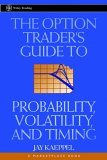What Exactly Is Delta?
Up till last week, my understanding of an option's delta is that it represents the option price movement for a one point change in the underlying instrument. This means that if an option has delta of 0.5, the option price will move $0.5 for every $1 move in the stock, assuming all other variables constant.
I also understand that a OTM option has delta between 0-0.5; ATM option has 0.5 delta; ITM option has delta between 0.5-1.0, increasing as it gets further ITM. I am also aware that for the same strike, a front month option will have a higher delta than the next month option. But I never quite understand why, until I saw an article on "Delta for the rest of us" by Brian Overby in the Oct issue of Options Trader Magazine
In this clearly written article, he said that market makers define delta as "the option's probability of being ITM at expiration". Enlightenment! This definition makes much more sense than textbook explanation.
In other words, an ATM option has delta of 0.5 because it has 50% chance of expiring ITM. If say a stock is trading @$62 now & expiration is say this Fri. A current month 60 Call will have delta of say 0.95 as this option is highly likely (has 95% chance)to stay ITM with only a few days to expiration. On the other hand, a next month 60 Call has more time to move, hence likelihood of staying ITM at expiration is lower, which results in lower delta.
But the story is reverse for OTM options delta. A next month OTM option will have higher delta than current month OTM option, because as Brian says "If you are buying OTM options, time is your friend", so there is more time for the next month OTM option to move ITM by expiration, hence next month OTM option has higher delta.
Hope you have a better understanding of delta after reading this.
I also understand that a OTM option has delta between 0-0.5; ATM option has 0.5 delta; ITM option has delta between 0.5-1.0, increasing as it gets further ITM. I am also aware that for the same strike, a front month option will have a higher delta than the next month option. But I never quite understand why, until I saw an article on "Delta for the rest of us" by Brian Overby in the Oct issue of Options Trader Magazine
In this clearly written article, he said that market makers define delta as "the option's probability of being ITM at expiration". Enlightenment! This definition makes much more sense than textbook explanation.
In other words, an ATM option has delta of 0.5 because it has 50% chance of expiring ITM. If say a stock is trading @$62 now & expiration is say this Fri. A current month 60 Call will have delta of say 0.95 as this option is highly likely (has 95% chance)to stay ITM with only a few days to expiration. On the other hand, a next month 60 Call has more time to move, hence likelihood of staying ITM at expiration is lower, which results in lower delta.
But the story is reverse for OTM options delta. A next month OTM option will have higher delta than current month OTM option, because as Brian says "If you are buying OTM options, time is your friend", so there is more time for the next month OTM option to move ITM by expiration, hence next month OTM option has higher delta.
Hope you have a better understanding of delta after reading this.


















0 Comments:
Post a Comment
<< Home